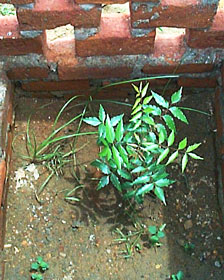My four week old hibiscus plants were beginning to show the first signs that they were attracting unwelcome visitors. The stem had soft whilte blobs sticking to it, though the plants were themselves looking healthy, what with a regular dose of organic manures like vermiwash, vermicompost and Bions (combination of beneficial microbes) keeping them well nourished.
The signs seemed to be the unmistakable early arrivals of sap sucking insects, which could inevitably invade the rest of the plants, branches and all and ensure their untimely death.
As a believer in the organic way, I scouted for the best solution. My friends said it could be diluted cow's urine (buffaloes are excluded)or neem oil or neem pesticide sprayed in a base of toilet soap solution (detergents are excluded).

All went well and the spraying was done using Neemgold (0.03 per cent) manufactured by SPIC. But in less than 12 hours, I discovered to my horror that some of the pesticide had bound itself to the leaf so strongly that they appeared partly "scorched" or "scalded."
Here is my analysis of what could have possibly gone wrong:
The neem pesticide, though among the least potent in terms of parts per million, was still too concentrated for the Hibiscus. It should have been diluted much more than the 1 part per 2 parts of soap solution that I had made. I would think it should have been only one part to six or eight parts of soap solution, or even ten.
Anyway, the story does not have a very morbid ending. The plant was still relatively untouched, and the bulk of its leaves were intact.
On the advice of my friends, I resorted to spraying of vermiwash (diluted one part to 8 parts water).
If you have any advice on this particular pesticide - there was no leaflet provided at SPIC's Manjari outlet in Kotturpuram - please do email me.
Eight weeks after using a high dose of azadirachtin to handle the pests of the hibiscus, one plant did not survive. Perhaps the failure to revive was not based entirely on the biopesticide, but also on the fact that the sapling was potted in compost in the bottom layers had not fully broken down. The resultant heat could have killed it.
As of October 2004, the second surviving plant lost a lot of its leaves but did not present a picture of complete death. It is sought to be revived with the use of "panchakavya" an organic pesticide-cum-tonic and a herbal spray, each diluted in water at three per cent.